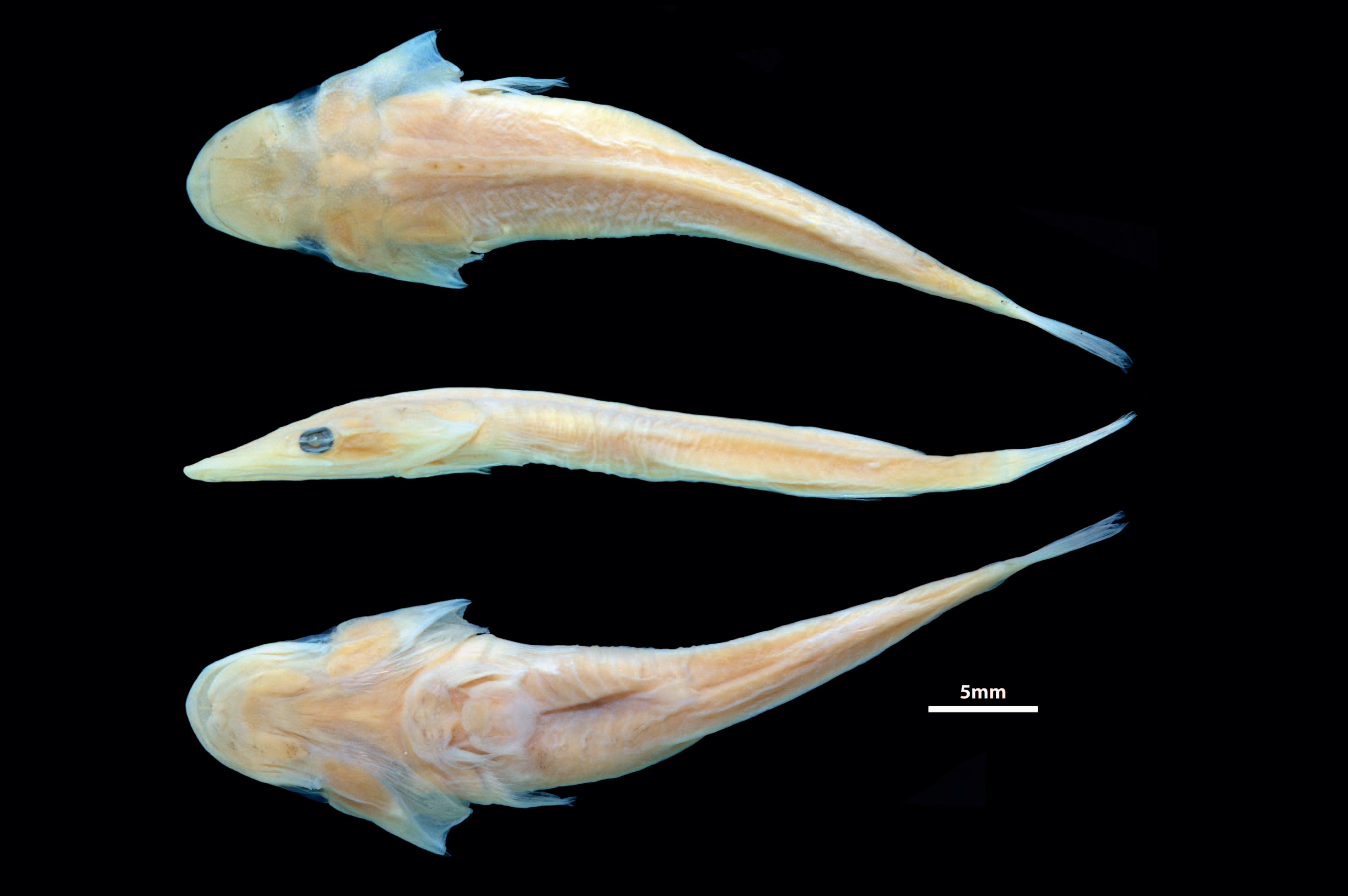Duckbilled Clingfish, Nettorhamphos radula Conway, Moore & Summers 2017

Holotype of the Duckbilled Clingfish, Nettorhamphos radula, from Five Fathom Bank off Fremantle, Western Australia, depth 33m - WAM P.26052-004. Source: Kevin Conway (Texas A&M University) & Glenn Moore (Western Australian Museum), in Copeia 105(1): 129, Fig. 1. License: All rights reserved
Summary:
A clingfish with a broad, flattened overhanging snout (not unlike the bill of a duck), and multiple rows of tiny dagger-like, conical teeth in both jaws.
Cite this page as:
Bray, D.J. 2022, Nettorhamphos radula in Fishes of Australia, accessed 17 Apr 2025, https://fishesofaustralia.net.au/Home/species/5320
Duckbilled Clingfish, Nettorhamphos radula Conway, Moore & Summers 2017
More Info
|
Distribution |
Only known from two specimens collected from algal/sponge reefs on Five Fathom Bank, off Fremantle, Western Australia, depth 33–37 m. |
|
Features |
Dorsal fin 5-6; Anal fin 7-8; Caudal fin (principal rays) 4-5, dorsal procurrent rays 3, ventral procurrent rays 2. Pectoral fin 21-22; Pelvic fin I.4. All rays segmented and unbranched. Snout broad, depressed, rounded anteriorly; lower jaw shorter than upper jaw; strong spine present on side of head formed by a well-developed and heavily ossified subopercular bone; large gill openings joined across the isthmus; dorsal fin with fewer rays than anal fin, both dorsal and anal fins widely separated from caudal fin; adhesive disc double with a papillae pattern including a continuous band of papillae across centre of disc region A and unpaired patches of papillae in disc regions C and D. Teeth in jaws tiny conical, arranged in ~15 regular rows along each side of the upper jaw (with ~40–50 teeth per row) and ~10 regular rows along each side of the lower jaw (with ~30–40 teeth per row). Lower jaw of paratype with a single row of 8 large, peg-like conical teeth anteriorly (four teeth on each dentary), which are absent from the lower jaw of the holotype. |
|
Colour |
In preservative: head and body background colour pale cream, light brown; dorsal surface of head with small, evenly spaced yellow spots tentatively identified as remnants of xanthophores (holotype only). Colour in life unknown. |
|
Remarks |
The Duckbilled Clingfish is tentatively considered a close relative of two other southern Australian endemic clingfishes, Posidonichthys and the undescribed “Genus A”, based on the presence of a well-developed and heavily ossified subopercular bone that articulates strongly with both the opercle (dorsally) and the preopercle (anteriorly) (Conway et al, 2017). |
|
Etymology |
Nettorhamphos is from the Greek words netta (duck), and rhamphos (bill, curved-beak), in reference the the curved overhanging snout of this species. The specific name radula is from the Latin radula (a tool used for scraping) in reference to the many tiny conical teeth on the lingual surface of the premaxilla and dentary, which are reminiscent of the radula of a snail. |
|
Species Citation |
Nettorhamphos radula Conway, Moore & Summers 2017, Copeia 105(1): 130, Figs 1-12. Type locality: Australia, Western Australia, Indian Ocean, west of Five Fathom Bank, 33 m, 32°11'S, 115°34'E. |
|
Author |
Bray, D.J. 2022 |
|
Resources |
Duckbilled Clingfish, Nettorhamphos radula Conway, Moore & Summers 2017
References
Conway, K.W., Moore, G.I. & Summers, A.P. 2017. A New Genus and Species of Clingfish (Teleostei: Gobiesocidae) from Western Australia. Copeia 105(1): 128–140. DOI: 10.1643/CI-16-560




